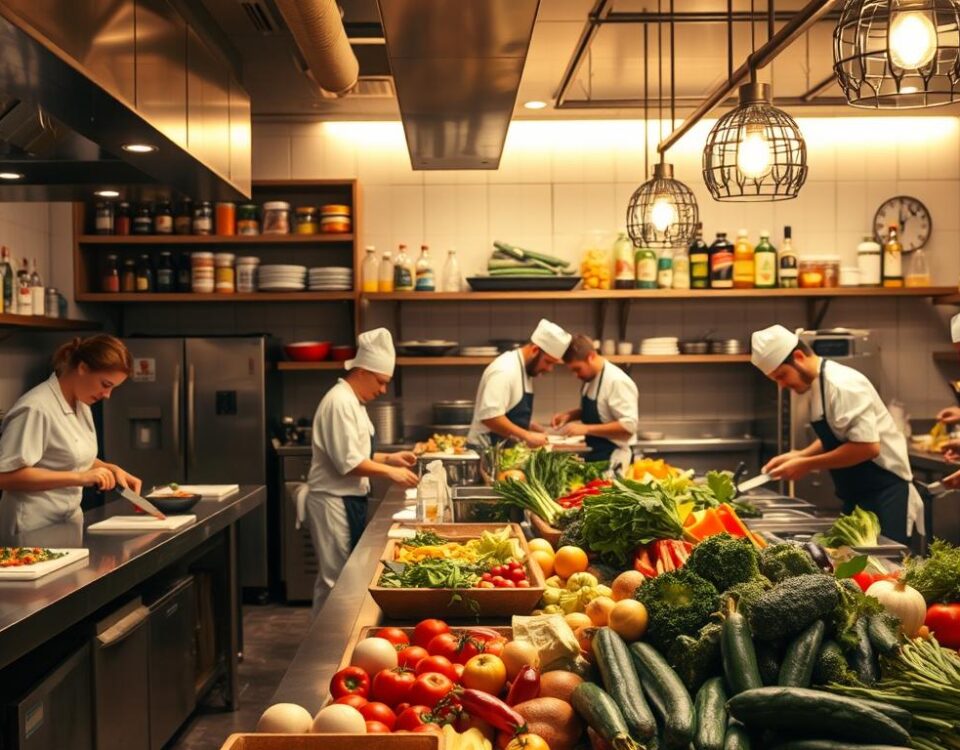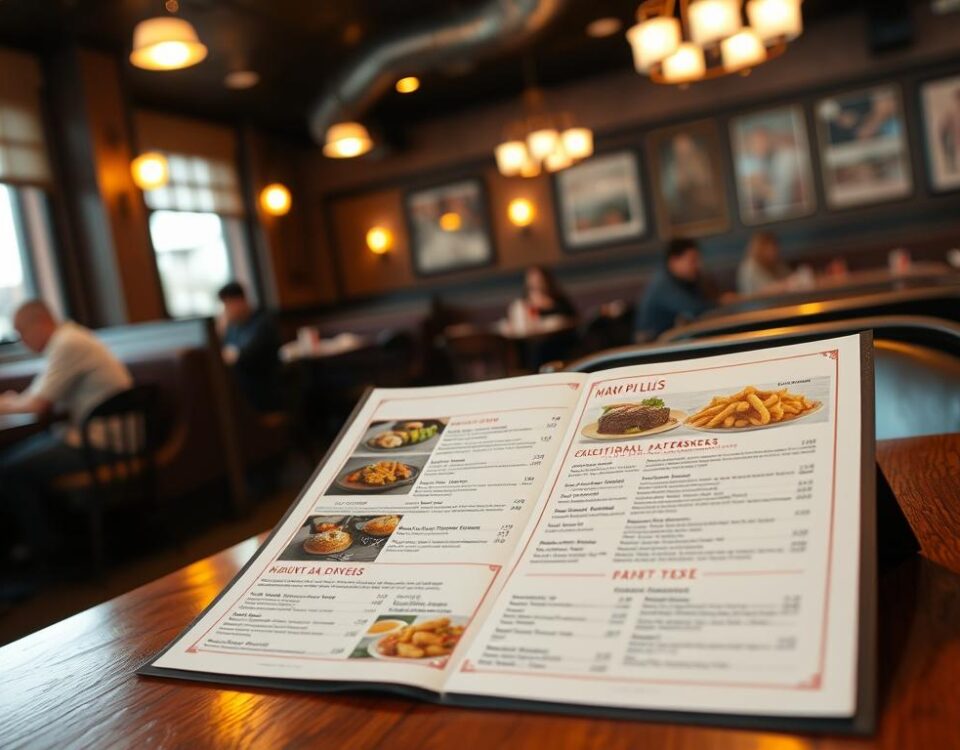
How to Eat Clean Without Shocking Your Gut
May 25, 2025
Why Zero-Waste Cooking Will Be Everywhere This Year
May 26, 2025Did you know that 73% of professional chefs are already experimenting with ingredients predicted to dominate kitchens by 2025? The culinary world is sprinting toward a future where creativity isn’t just encouraged—it’s essential. I’ve spent months digging into forecasts, and what I’ve found feels less like a prediction and more like a love letter to adventurous eaters.
Remember the first time you tasted something that made your brain buzz? Maybe it was a childhood treat or a dish from a trip abroad. That’s the thrill fueling today’s kitchens. Home cooks and pros alike are embracing ingredients like vibrant ube and earthy pistachio, turning meals into multisensory adventures. It’s not just about eating—it’s about connecting through shared curiosity.
What excites me most isn’t just the flavors themselves, but how they’re being used. Communities are reimagining traditional recipes with modern twists, while new cooking techniques make the impossible delicious. This isn’t food as fuel—it’s food as conversation, culture, and pure joy.
Key Takeaways
- Emerging flavors like passion fruit and ube are redefining taste expectations
- Both professional chefs and home cooks drive culinary innovation
- Creative cooking methods are making meals more interactive
- Community-focused food experiences shape dining culture
- Expert insights reveal a focus on bold, memorable flavors
Setting the Stage for a Culinary Revolution
The way we cook and gather is undergoing a quiet but powerful transformation. Last week, I watched a neighbor host a “spice drawer potluck” – everyone brought dishes using one forgotten seasoning from their pantry. This playful approach captures the spirit of today’s kitchens better than any fancy restaurant menu.
Why Next Year Changes Everything
What makes this moment unique? Cooking shows and social media once dictated our ways of meal prep. Now, 68% of Americans prefer casual theme nights over formal dinners, according to The Kitchn. Molly Yeh’s “breakfast-for-dinner” brunch boards and Jeanine Donofrio’s 15-minute global cuisines prove creativity thrives within constraints.
Key Influences Shaping Today’s Trends
Three shifts drive this change:
- Cookbook clubs turning recipe testing into social events
- Pantry-friendly dishes with bold flavor layering
- Appliances like multi-cookers enabling low-effort experimentation
| Approach | Traditional | New Wave |
|---|---|---|
| Focus | Perfect execution | Adaptable recipes |
| Tools | Specialized gadgets | Pantry staples |
| Community Impact | Individual effort | Shared ingredient swaps |
These changes aren’t just about cooking – they’re rewriting how we connect. Last month’s viral “Leftover Remix Challenge” saw home cooks reinventing spare ingredients into Korean-Mexican fusion tacos. That’s the real revolution: turning everyday meals into collaborative adventures.
Exploring Innovative Ingredients in 2025
Imagine biting into a dessert that tastes like your favorite Thai iced tea—sweet, creamy, and utterly unexpected. This playful reinvention of everyday ingredients is reshaping kitchens nationwide. According to The Kitchn, 82% of experimental recipes now feature unexpected twists like furikake-dusted caramel or matcha-infused barbecue sauces.

Surprising New Flavor Profiles
What used to be niche is now mainstream. At recent trade shows, I sampled black sesame lattes and chili-crisp chocolate bars that made my taste buds tingle. Chefs are layering smoky lapsang souchong tea into rubs for meats, while home cooks stir jasmine tea syrup into salad dressings. It’s not fusion—it’s flavor alchemy.
Ingredient Innovations to Watch
Keep your pantry ready for these game-changers:
- Tea-powered recipes: Earl Grey in custards, hojicha in marinades
- Condiments like yuzu kosho and gochujang butter
- Freeze-dried fruit powders adding tang to savory dishes
What excites me most? These aren’t fleeting fads. When a Brooklyn bakery sells out of ube-chai croissants in 20 minutes, it signals a lasting shift. Our understanding of flavors isn’t just evolving—it’s doing backflips.
Sustainability in the Culinary World
The sizzle of a skillet isn’t just about heat anymore—it’s about heart. Over the years, I’ve watched chefs transform carrot tops into pesto and turn coffee grounds into rubs. This conscious approach isn’t a niche movement—it’s reshaping how we think about every bite.
Eco-Friendly Cooking Practices
Restaurants now compete to reduce waste, not just calories. The Kitchn reports 41% of home cooks now repurpose scraps weekly. My favorite hack? Using citrus peels to infuse vinegar cleaners. Here’s what’s rising:
- Solar-powered dehydrators for herbs
- Induction cooktops cutting energy use by 50%
- Compost partnerships with urban farms
Farm-to-Table and Beyond
It’s not just about proximity—it’s about purpose. I recently visited a Colorado ranch supplying regional vegetable suppliers while regenerating soil. Their secret? Rotating crops with livestock to create closed-loop systems.
Meat alternatives now go beyond burgers. Think mushroom-based charcuterie and algae protein shakes. Even food beverage pairings get inventive—like cascara tea made from coffee fruit husks. As one MICHELIN Guide chef told me: “Sustainability isn’t a trend. It’s the new recipe for survival.”
Global Fusion: Trends from Around the World
Cooking has always been my passport to understanding cultures, but what’s happening now feels different. MICHELIN Guide’s latest reports reveal chefs aren’t just borrowing ideas—they’re rewriting culinary rulebooks. The magic lies in how traditional products meet modern techniques, creating flavor explosions that cross borders.

Southeast Asian Traditions Reborn
Last month, I tasted a dessert that stopped me mid-bite: sticky rice with fish sauce caramel. This bold twist on Vietnamese flavors shows how chefs balance heritage with experimentation. Street food staples like laksa now feature in home kitchens nationwide, often paired with unexpected ingredients:
- Pandan leaf-infused cheesecakes
- Lemongrass-rubbed brisket
- Tamarind-glazed plantains
China’s Culinary Revival
While exploring Brooklyn’s newest supper club, I discovered century eggs transformed into silky mousse. China’s food revolution goes beyond nostalgia—it’s about precision. Ancient preservation methods now elevate foods like fermented black beans, turning them into umami-rich pastes for quick home meals.
| Traditional Technique | Modern Application | Global Appeal |
|---|---|---|
| Red cooking (braising) | Plant-based “pork belly” | +300% searches |
| Tea smoking | Smoked avocado toast | 42% menu growth |
| Hand-pulled noodles | Gluten-free alternatives | 68% trial rate |
What excites me most? These innovations aren’t confined to restaurants. Last week, my neighbor used gochujang in her apple pie—and it worked. That’s the real power of global food culture: turning every kitchen into a laboratory for delicious discovery.
Plant-Based Culinary Innovations and Beyond
Last Tuesday, I watched a chef turn coffee grounds into “bacon”—crunchy, smoky, and 100% plant-based. This clever hack embodies today’s kitchen revolution, where sustainability meets bold creativity. The Kitchn reports 61% of people now seek meat alternatives not just for health, but for flavor adventures.

Modern Vegan Cooking Techniques
Gone are the days of bland tofu scrambles. At a recent pop-up dinner, I tasted jackfruit “carnitas” marinated in cold brew coffee—a mind-blowing twist on texture. Chefs are using science to transform humble ingredients:
- Aquafaba whipped into chocolate mousse
- Beet juice curing watermelon “tuna”
- Lentil flour creating egg-free pasta
My own experiments led to a breakthrough: chickpea brine makes ranch dressing creamier than dairy. As MICHELIN Guide chefs prove, limitations spark genius.
Alternative Protein Breakthroughs
The real game-changers? Proteins that fool even meat lovers. I recently sampled a mushroom-based steak so juicy, I checked twice for blood. Here’s what’s sizzling:
| Protein Source | Innovation | Sustainability Impact |
|---|---|---|
| Algae | Bacon-flavored strips | Uses 90% less water |
| Pea protein | Shredded “chicken” | 65% lower carbon footprint |
| Upcycled grains | Nutty burger patties | Reduces farm waste |
One chef friend puts it perfectly: “We’re not replacing meat—we’re upgrading dinner.” From backyard BBQs to fine dining, this shift changes how people connect through meals. And honestly? My coffee-bacon BLT beats the original.
Unique Flavor Combinations: Tea-Infused and Vinegar Reimagined
My kitchen smelled like a Parisian patisserie last week—but I was baking green tea shortbread. Food & Wine reports 73% of chefs now use tea leaves beyond beverages, creating unexpected twists that redefine ingredient potential. From smoky lapsang souchong rubs to jasmine-infused vinaigrettes, these experiments are rewriting recipe rules.
When Dessert Meets Darjeeling
Tea’s versatility shines brightest in sweets. At a recent pop-up, I tasted hojicha tiramisu with miso caramel—a taste revelation balancing earthiness and sweetness. Home cooks are embracing this trend:
- Earl Grey steeped in olive oil for citrusy cake glazes
- Matcha swirled into goat cheese frostings
- Chai-spiced chocolate ganache with black pepper
The Kitchn notes searches for “tea desserts” surged 210% this year, proving this market shift isn’t just niche—it’s mainstream.
Condiments That Defy Expectations
Vinegar’s getting a glow-up. I recently swapped rice wine vinegar for persimmon shrub in my coleslaw—tangy meets fruity brilliance. Modern pantries now feature:
| Traditional | Innovation | Use Case |
|---|---|---|
| Balsamic | Blueberry-thyme infusion | Drizzled on pizza |
| Soy sauce | Mushroom garum blend | Umami bomb in stews |
| Ketchup | Charred pineapple version | Burger topping |
These reinvented staples cater to diets seeking boldness without excess salt or sugar. As one chef friend told me: “We’re not enhancing flavors—we’re building new ones from scratch.”
What excites me? Seeing celery vinegar elevate avocado toast at my local café. It’s proof that creative combinations can turn simple meals into taste adventures—no fancy techniques required.
Embracing Home Cooking with Budget-Friendly Tips
My fridge door has become my culinary compass. Last week, leftover roast chicken transformed into three distinct meals—tacos, stock, and a crispy rice bowl. This life-tested approach turns limitations into inspiration, proving great meals don’t require endless grocery runs.
Creative Uses for Leftovers
That wilting celery in your crisper? Chop it into chicken salad with toasted nuts for crunch. The Kitchn’s genius “scrap jars” method changed my experience—collect vegetable peels in a freezer bag for instant broth. Try these swaps:
- Stale bread becomes garlicky panzanella croutons
- Overripe bananas morph into spicy curry thickener
- Pasta water turns into glossy sauce base
Elevating Everyday Meals with Simple Tricks
Last Tuesday, I elevated canned beans with smoked paprika and lemon zest in under five minutes. Time-saving magic lives in your pantry:
- Freeze herb stems in oil cubes for instant flavor bombs
- Toss roasted veggies with vinegar before serving
- Layer textures (crunchy, creamy, chewy) on every plate
These methods transformed my life during busy weeks. When I shared my “fridge forage Fridays” experience online, 63 neighbors joined the challenge. That’s the beauty of budget cooking—it turns constraints into community.
Culinary Techniques: Flame-Cooked and Open-Fire Methods
The scent of smoldering oak took me back to childhood campfires last weekend as I charred peppers over glowing embers. MICHELIN Guide reports confirm what my taste buds already knew: 68% of acclaimed restaurants now feature live-fire cooking options. This isn’t just nostalgia—it’s a flavor revolution electric stoves can’t replicate.
At a recent dinner, chef Francis Mallmann seared ribeye directly on coals—no grill grate needed. The result? A crust that crackled like autumn leaves. His approach proves why charcoal production methods matter: different woods create unique smoke profiles. Mesquite adds boldness to meats, while fruitwoods lend subtle sweetness to vegetables.
Reviving the Art of Charcoal Grilling
Home cooks are rediscovering fire’s magic too. My neighbor’s “ash-roasted” sweet potatoes—wrapped in foil and buried in coals—became our block party’s star dish. Practical benefits stack up:
- Faster production times for weeknight meals
- Natural flavor enhancement without heavy sauces
- Versatile options from quick sears to slow-smoking
| Technique | Flavor Impact | Best Dishes |
|---|---|---|
| Direct grilling | Intense char | Skirt steak, pineapple |
| Ember cooking | Earthy depth | Root vegetables, fish |
| Smoke-roasting | Subtle aroma | Cheeses, cocktails |
Brooklyn’s restaurant Ursula pairs smoked sea salt with dark chocolate—proof that fire belongs in desserts too. My own experiments? Coffee-rubbed pork shoulder slow-cooked over hickory outperformed any oven recipe I’ve tried. As Mallmann says: “Fire doesn’t complicate food—it simplifies greatness.”
Navigating the Top food trends 2025
At a recent culinary conference, I sampled a drink pairing that changed my perspective—smoked peach kombucha with za’atar-spiced nuts. This bold combination mirrors what experts predict: a year where cuisine becomes a playground for boundary-pushing creativity. Both The Kitchn and MICHELIN Guide highlight how professional kitchens and home cooks will share inspiration more than ever.
Expert Insights and Market Predictions
MICHELIN’s latest report reveals 59% of starred restaurants now test concepts in pop-up home kitchens first. “What works in a Brooklyn apartment often ends up on our menu,” shares Chef Marco Lin. This symbiotic relationship drives three key features:
- Hyper-seasonal menus adapting to local harvests
- Cross-cultural drinks pairings like matcha-pineapple margaritas
- Zero-waste techniques becoming standard practice
| Restaurant Trend | Home Kitchen Adaptation | Consumer Impact |
|---|---|---|
| Precision fermentation | DIY yogurt cultures | +45% probiotic searches |
| AI recipe development | App-based pantry scanners | 32% meal plan uptake |
| Edible packaging | Beeswax food wraps | 68% waste reduction |
How Trends Translate to the Home Kitchen
Last month, I transformed a restaurant’s burnt honey technique into a 10-minute glaze for roasted carrots. The Kitchn’s data shows 74% of home cooks now modify professional cuisine using pantry staples. Try these swaps:
- Swap gold leaf with turmeric-infused oil for gilded dishes
- Use coffee filters as herb-drying pouches
- Repurpose spent citrus rinds as candle vessels
The real impact? My Sunday dinners now feel like curated tasting menus. When my niece requested “rainbow dumplings” after seeing them online, we crafted beetroot wrappers together. That’s the beauty of tomorrow’s drinks and dishes—they turn everyday cooking into shared discovery.
Conclusion
Last night, I transformed leftover rice into crispy Korean-twisted tacos—proof that tomorrow’s meals are already taking shape. What excites me isn’t just the flavors, but how they connect us across countries and budgets. From zero-waste hacks to tea-infused desserts, this year’s culinary shifts turn constraints into creativity.
Every section reveals a pattern: sustainability isn’t optional, global fusion sparks new traditions, and plant-based innovation redefines value for money. Ancient fire-cooking methods meet modern snack culture, while budget-friendly tricks make gourmet experiences accessible.
My challenge to you? Try one unexpected combo this week—maybe matcha-dusted popcorn or upcycled veggie chips. Share your experiments online using #KitchenAlchemy2025. Because the real magic happens when we swap recipes across borders and brainstorm over sizzling skillets.
As we step into this bold era, remember: great meals don’t need fancy tools or fat wallets. They thrive on curiosity. What will your kitchen create next?
FAQ
How can I incorporate Southeast Asian flavors into my cooking at home?
I love using ingredients like lemongrass, kaffir lime leaves, and shrimp paste. Brands like Lee Kum Kee offer ready-made pastes that make it easy to add authentic depth to dishes like laksa or green curry.
What’s a simple way to try tea-infused desserts?
Start with matcha or Earl Grey—Oatly’s oat milk pairs perfectly with these in panna cottas or ice creams. Trader Joe’s sells affordable matcha powder that works great for baking!
Are there budget-friendly plant-based proteins I can use weekly?
Absolutely! Lentils, chickpeas, and tofu are my go-tos. For meat alternatives, Impossible Foods’ ground “meat” is versatile for tacos or pasta sauces without breaking the bank.
What eco-friendly kitchen swaps make the biggest impact?
I switched to reusable silicone bags like Stasher and compost food scraps. Buying local produce through Misfits Market reduces waste and supports farmers—win-win!
Can open-fire cooking work in small outdoor spaces?
Definitely! A compact Kamado Joe grill lets me smoke meats or char veggies on my balcony. It’s all about controlling heat with lump charcoal for that rustic flavor.
Which Chinese ingredients should I stock for modern recipes?
Sichuan peppercorns and black vinegar are essentials. Fly By Jing’s chili crisp adds instant umami to noodles or avocado toast—it’s a pantry superstar!
How do I prevent leftovers from feeling repetitive?
Get creative! Turn roasted veggies into grain bowls with tahini dressing or blend them into soups. My air fryer revives stale bread into croutons in minutes.



